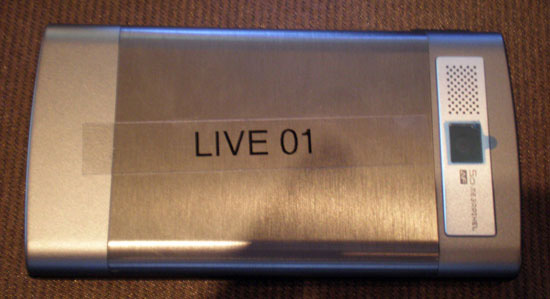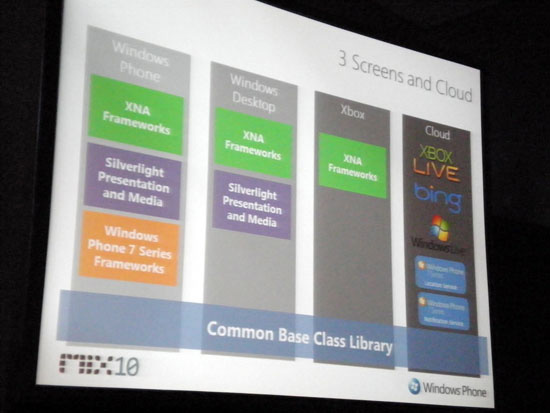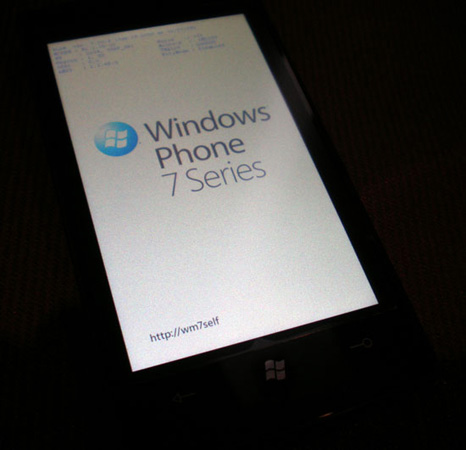Windows Phone 7: The AnandTech Guide
by Brian Klug on March 21, 2010 12:00 AM EST- Posted in
- Smartphones
- Windows Phone 7
- Mobile
Gaming on Windows Phone 7 Series
On the last day of MIX10 I got a very special chance to sit down for a little over an hour with Andre Vrignaud (who works with the Advanced Technology Group at Microsoft on Xbox LIVE) and an ASUS-built WP7S prototype. We proceeded to have a discussion about the future of the platform with a copy of it in front of us.

Unbranded ASUS hardware - Back
The first thing we did was fire up a copy of the XNA-framework-leveraging gaming title, "The Harvest." If you haven't noticed already, this simple yet compelling game demo has become the paradigm example Microsoft has selected to advocate two core features it hopes make WP7S a compelling gaming platform. I've gone over this previously, but bear with me. First is the power of code re-use across what Microsoft is calling the "three-screens" users interface with: TV (through Xbox 360), the desktop (Games for Windows), and now WP7S.

3 Screens, Frameworks
The Harvest reuses 90% of its code between the three platforms, as well as virtually all the artwork and textures, and was developed in 3 weeks by developer Luma Arcade. With the exception of the input paradigm, which is different from Xbox to PC to WP7S, this is virtually the exact same game running at the exact same resolution across all three screens. Second is the power of leveraging cloud services already offered by Microsoft like Xbox LIVE for seamless integration across those three screens. That means the same avatar, same friends, same communication tools, and potentially even persistent gamestates across them.
I managed to get continuous video of the device booting (so we can see the boot splash screen), a bit of interface, and 80% of the level:
I snagged what I believe to be the first photo of WP7S' boot splash screen.

Apologies for the depth of focus at the top; unfortunately the build details aren't visible. Most I can make out are the words "Region," "Build," "BIOS," and "[...] 29, 2010." If you want to pick apart the original image, you can find it in the gallery. Either way, it isn't really important since there were so many different builds of WP7S running around the entire conference.
The first thing that struck me while playing with the demo was how little justice any of the videos I've seen so far do the title; it looks fabulous. That's likely a function of the dot pitch of the 800 x 480, 3.7" display well exceeding the spatial resolution of the video hardware media venues (myself included) are using to record the phone. I think it's safe to say it looks above the quality of titles I've seen on any Android hardware or the iPhone 3GS. And this is without any custom programmable shaders to boot! More on that later. My point is that there's something lost in all of these demonstrations until you really get to sit down and try the hardware yourself.
Qualitatively, this hands-on felt smoother and like it had a higher average framerate than in the demonstration video from the keynote in our previous article. Pay attention specifically to how framerate remains largely unaffected when the achievement unlock bar transitions down and back up. Now compare that to the previous video. It didn't feel nearly as laggy here.
Next up was Goo Splat, a Zune HD game written in XNA Game Studio 3.1 which was ported to XNA Game Studio 4.0 and WP7S. What's important here is that the title leverages four point multitouch. Why four point when all apps predominantly use a maximum of two? To afford developers the flexibility to make games and other software leveraging much more complicated input schemes. And to of course support creatures with more index fingers and thumbs.
It's fair to say that porting games from XNA GS 3.1 to XNA GS 4.0 will be a lot easer than trying to play multitouch games while recording them at the same time.
Andre and I talked about what casual gamers can expect to get out of WP7S. FPS titles are still the bread and butter of both console and PC gaming, but I asked about what genres he thinks will really leverage the unique set of strengths and weaknesses present on a handset. His answer was asynchronous gaming, and I think this is largely where cloud service integration will shine. Users check their phones when they have time - in line, waiting at a bus stop, walking, or while being idle. It's in these few moments of downtime that Andre (and the rest of the XNA team) hopes will live an asynchronus game of scrabble or turn based strategy against another opponent with a WP7S device.
This is where the potential of leveraging Xbox LIVE's existing userbase, as well as WP7S really could shine. I asked Andre if a Gold subscription was required to get in on WP7S gaming, and his answer was no - all WP7S games will work with a free silver account.










55 Comments
View All Comments
nerdtalker - Sunday, March 21, 2010 - link
Noted and fixed! Thanks!Cheers,
-Brian
StormyParis - Sunday, March 21, 2010 - link
It seems so close to the whole iPhone thing, that if I were MS I'd be embarassed... a lot of pride swallowing must have been going on.My issue is, I can't find a good reason to want these phones. Even Office integration doesn't cut it, because the hardware is so gimped that I'd never, ever, want to do any office work with it. The rest is just regular smartphone stuff. As with Apple, I lose a whole lot of freedom of features (forced to use IE ? IE ??? back to web 0.8, guys). And my personnal guess would be that for the same loss, I get less in exchange, in terms of ease of use and features.
Hopefully Google and Nokia will manage to keep their ecosystems open, because those "censored apps, censored hardware, no extensions nor upgrades" e-dystopias have me worried and slightly despondent.
NJoy - Sunday, March 21, 2010 - link
avid user of WM for last 5 years, now I'm so disappointed, it's even depressing. They just have killed everything what I liked about WinMo. SadCSMR - Sunday, March 21, 2010 - link
Extremely disappointing to be given a locked down system from Microsoft, missing essential capability that's been around for over a decade.Instead of continually expanding features and technology, and providing a better user interface, we have a locked down system with a long list of basic missing features. Windows Mobile has been downgraded from an operating system to firmware with this release.
Even the user interface, supposedly "stylish" is almost everywhere an inefficient use of space to present information. It's fine to pander to customers who want that... but now there's no way to customize it to something better.
Other features removed: No microSD cards, incredible! No file system access! Anyone who understands what a file is should avoid this system.
I can see the benefits for the computer-illiterate, but for us and for business users why not make an open "Windows Mobile 7 Business" version without the limitations?
wolrah - Sunday, March 21, 2010 - link
The carriers need the shiny new phones to attract customers, not the other way around. The consumer cares more about the thing they're carrying rather than the network it's on (see iPhone and AT&T). With that in mind, the experience of a mobile phone OS should be about the user, not the carrier.The ability for carriers to screw with phones is almost universally a bad thing. The CDMA carriers' love of BREW on dumbphones, Verizon's obsession with crippling devices, AT&T's lockdown of the Backflip and the previous heavy limits on "bandwidth intense" iPhone apps, etc. I don't think I need to go on to show that the carriers should never be allowed to influence phones in the slightest. I can not come up with a single example where carrier modifications were a benefit for the end user even on dumbphones, much less on smartphones.
The bit about appeasing carriers worried about becoming "dumb pipes" is the problem in a nutshell. They are dumb pipes, that's the point. They provide the spectrum and backhaul lines that connect my phone to the PSTN and Internet. Saying that telecom carriers don't want to be dumb pipes is like saying that Ford doesn't want to be a car company. It just doesn't make sense, since that's exactly what they are.
trochevs - Sunday, March 21, 2010 - link
I agree with you. Unfortunately we have two serious obstacles here. First is the brainwashed US consumer who thinks he/she is getting better deal by getting locked phone from US carrier for free or discounted price from artificially inflated price of unlocked phone.The US consumer are scripted so well and never stop to think for a minute. Just notice poor sales figures in USA for unlocked phones from Nokia, Sony and Google are.
Second is the monopolistic behavior of US carriers. For many years they did not allowed unlocked phones on their networks. Only when real threat of regulation become evident they start allowing it. But they pile your phone bill with extra fees that makes you think twice. Not only that, but they keep charge you exact same monthly service fee even when everyone knows that this fee includes the price of the phone.
anactoraaron - Sunday, March 21, 2010 - link
not to mention the monopolistic reality of government agencies allowing these carriers to buy out all of the smaller, local companies. There is this trend of broken economics going on here and we, the "end users," are the ones paying for it (literally). Once where I live here there were 4 smaller companies my "unlocked" phone would work on.... now "unlocked" phones are almost all just ATT and T Mobile.trochevs - Sunday, March 21, 2010 - link
Well. Thanks Brian for great article and thanks AnandTech for great coverage of Windows Phone 7 so far.From what I see WP7 is targeted directly against Apple iPhone not Google's Android. Apple is attacking HTC to hurt Android, but looks like Steve jobs did not learn his lesson. The real hit will come from Microsoft again. MS is taking advantage that all mobile operators are not happy with Apple keeping iPhone away from them. It will be slow switch for many iPhone users, but MS has the financial power to keep the WP7 alive for a while.
Google's Android has own problem now. Google compromised their relationship with open source community in order to meet the US mobile operators and handset manufactures demands, but now Android is facing the real possibility that US carriers are going to use Android as bargaining power to get better deal from MS. Just like Asus and other OEM did with early versions of netbooks and using have-baked Linux distributions. So Google needs to decide between Open Source community or discontinue Android in the long run and accept that US carriers will hold the key and can lock out Google if they want to.
So the key would be. How well Mr. Jobs and Mr. Schmidt have learn the lessons form recent and not so recent past. It will be fun watching. And the key player could turn to be Intel with their MeeGo.
FITCamaro - Sunday, March 21, 2010 - link
They're definitely going to have to allow applications like Pandora to run in the background or no one will buy the phone. I use Pandora on my Droid. If it killed Pandora any time I wanted to check my email, send a text message, or browse the web, I'd be be pissed.DigitalFreak - Sunday, March 21, 2010 - link
Unfortunately, it looks like they're going down the iPhone route and locking everything down. App store, no SD cards, etc. Really not surprising I guess when you look at how they handled the Xbox 360.